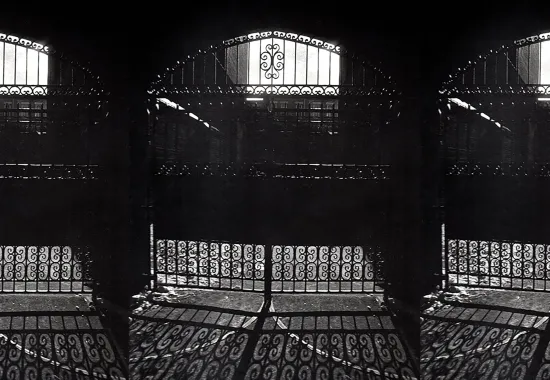A Review of Hoist House by Jenny Robertson
Sometimes, I feel as far away from the Midwest as the mileage I have put between us. I left Minnesota at eighteen and have not lived there since. My place of birth is like an overstuffed down jacket I packed away in a long, plastic box, shoved into a closet for a rare visit home. But other times, it hits me something fierce, takes my breath away like the first cold gasp of air. Jenny Robertson’s collection, Hoist House, made me ache for home, for a sense of place so palpable I could feel it stinging in my throat. A hoist house contains machinery that moves (objects, people) from below to above ground. The stories and novella, just like their namesake, lift the unseen to the surface.
 The short stories are driven by muscled, energetic prose, the sort of prose honed by years of manual labor. But there is a darkness, a sensuality that underpins each story. They are complex and surprisingly funny, despite the melancholy themes that dominate the collection. In “Sex-o-Rama,” a loincloth clad dom in thigh-high leather boots orchestrates sexual exploration at the Minneapolis mainstay First Avenue, while navigating the last hours of his estranged father’s life. The dom, Cher Bebe, followed Prince upriver from New Orleans, finding a place full of freaks where his presence was not just welcomed but needed. The story eschews tidy endings, lingering in the unfinishedness of hearing the last words of your father through a payphone as “CREAM” blares from the speakers. The juxtaposition of “Lifted,” which begins serenely enough with a walk through the woods on a well-worn footpath to a child’s bedroom windowsill lined with plastic figurines, haunts the reader with the suggestion of an inevitable assault as a man pries open the screen with a pocket knife.
The short stories are driven by muscled, energetic prose, the sort of prose honed by years of manual labor. But there is a darkness, a sensuality that underpins each story. They are complex and surprisingly funny, despite the melancholy themes that dominate the collection. In “Sex-o-Rama,” a loincloth clad dom in thigh-high leather boots orchestrates sexual exploration at the Minneapolis mainstay First Avenue, while navigating the last hours of his estranged father’s life. The dom, Cher Bebe, followed Prince upriver from New Orleans, finding a place full of freaks where his presence was not just welcomed but needed. The story eschews tidy endings, lingering in the unfinishedness of hearing the last words of your father through a payphone as “CREAM” blares from the speakers. The juxtaposition of “Lifted,” which begins serenely enough with a walk through the woods on a well-worn footpath to a child’s bedroom windowsill lined with plastic figurines, haunts the reader with the suggestion of an inevitable assault as a man pries open the screen with a pocket knife.
In “The Triumphant Return of Maggie Pancake,” one of the most original named protagonists in recent memory navigates a rather unglamorous return to her hometown bar after being dumped by her fiance, a professional clown. What is unearthed, by the fat logs of mozzarella from the bar and the run-ins with a cast of unsavory would-be suitors (one named Toad-Bear, another a former HS teacher), is not the grief of a jilted lover but instead the death of a friend. Maggie looks at the grim pickings saddled up to the bar and is hit with a powerful memory of comforting that dead friend in the bathroom ten years earlier, of holding her and keeping space for her after rejection. On a recent trip home I felt the same smack of a memory of my now-dead high school best friend—the two of us stepping out of a bar together hand in hand into the beginnings of a blizzard, very much sharp and alive on the curb staring at the fresh snow, unsoiled by car exhaust. Robertson lets the exposed sadness sit with you, the jarring details of a terminal illness interspersed with the escape of a drunken night trying to reclaim youth, and never relents.
“Ground Truth” also begins with a somewhat comedic premise—a compulsive storm tracker obsessed with the safety of his family, who speaks only in terms of tornados (he’s a “spotter, not a chaser”). The blended narrative recounts the devastation of a 1965 tornado touchdown with precision, weaving Len’s paranoia over previous storms with his focus on protecting his family as it unravels, all while another major tornado bears down on them. These stories push us to question our desires and the danger of suppressing them. The very thing Len fears comes to fruition and the story concludes with the lasting image of massive trees left “bottas arribas” (roots and boots up). While the question of how we can restore what has been ripped from us lingers on, we are also left with the assurance that we still try despite.
The true focal point of this collection, however, is the titular novella, a coming of age story set against the brutal backdrop of the Iron Range in the 1920s. Fourteen year-old Sadie and her family of Finnish immigrants struggle with the disillusionment of the American dream, a dream that grows more elusive each time Sadie’s father, brother, and the other immigrants in their community plunge into the depths of the earth to enrich the pockets of a few. The prose carefully depicts the realities of existing on the fringes, the sheer exhaustion of daily survival. Sadie contends with a brother who both attempts to assault her and brutally beats her would-be assaulter. Yet Sadie defies the harsh realities of her life by stealing joy—both figuratively and literally—wherever she can get it. Sadie and her brother are saddled with adult responsibilities and enter the workforce, but Sadie’s world becomes larger as she asserts herself, whereas her brother Karl’s world begins to collapse inward as he uses alcohol to cope with the brutal work of pulling valuable minerals from the earth while struggling to organize for workers’ rights. With a deft ear for dialect, Robertson relays how Sadie’s mother prepares her for the harsh reality of being born in a female body, orally passing on her own trauma with a warning: “No matter what they do Sadie, you don’t let them kill you.” Art and theater provide Sadie with a much needed respite, in the same vein that Robertson’s story provides hope for anyone who has ever been taught, first and foremost, “how to work” by their people, for anyone who has longed for something bigger than the routine of existence, exhaustion, rest, and repeat. Even though this reader knew, as I flipped the pages, that something terrible was coming, I still wept at the conclusion of the story, complete with its broken promises: indigenous people waiting for land, Karl seeking a worker’s revolution and finding disappointment in socialism, the false security of dangerous physical work. The dangers of wanting more, which Robertson recounts in gorgeous prose, at times reminiscent of a list poem–free associations of the time period immediately following the Milford Mining disaster. Sadie’s depiction of the men, “tucked into bed,” the endless wail of the siren, “its cord wrapped around the man who sounded it,” her delusional hope that there was a magic pocket where the men survived, are imprinted in my mind like a fresh track in the snow.
This brings me to perhaps the only criticism of the collection: perhaps Sadie deserved more space on the page, an entire novel devoted to her perspective. As Robertson writes, “none of this is new,” but Sadie’s fierce voice made these familiar themes fresh again. Even so, I was grateful to follow her journey, grateful for her pluck as she navigated all that was pushed up and found a way to seize her own path.






